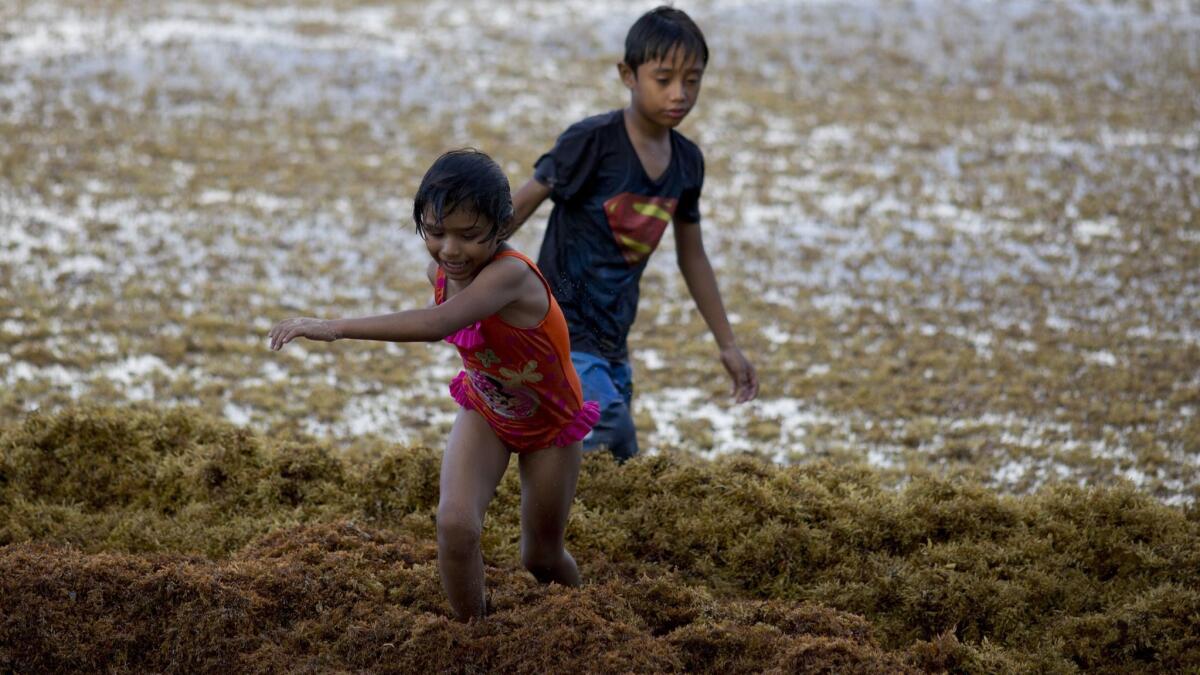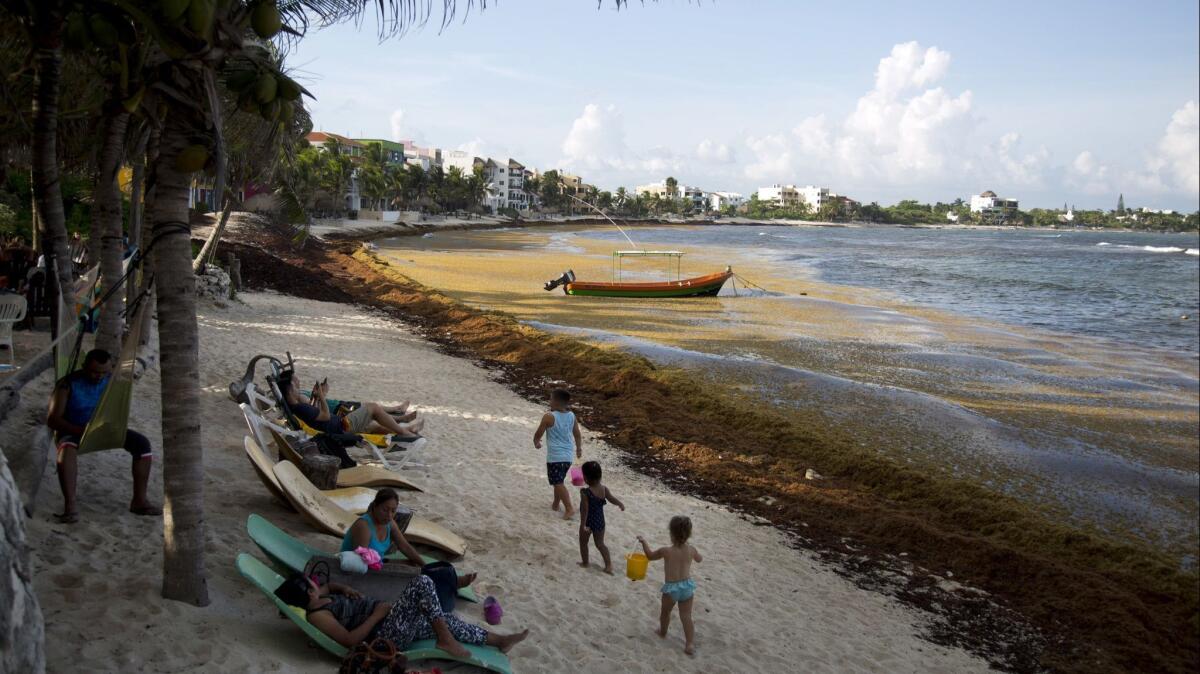Loads of seaweed are threatening the Caribbean’s sea life and tourism. Experts say we may be to blame

Reporting from Cancun, Mexico — Each morning along Mexico’s iconic Caribbean coast, workers with pitchforks ready themselves for another day of war against seaweed.
They haul it off the beach with plastic bags, tanker trucks and small tractors that rumble back and forth in front of sunbathing tourists. By the next morning, new heaps of seaweed have washed ashore and begun to decay — emitting a stench of rotten eggs — and the war starts anew.
This was not what Aymara Flores had promised her two children when she booked a vacation at a luxury Cancun resort.
“I always tell them Cancun is so beautiful, but it’s not the same now,” said Flores, 37, an executive from the northern Mexican state of Chihuahua, who found it impossible to swim without being scratched by prickly clumps of seaweed. “Honestly, it’s awful.”
From the shores of Barbados to Miami Beach, masses of stinking seaweed have been washing ashore, threatening fragile coastal ecosystems and sparking panic in nations that depend on the millions of tourists that flock to the region each year to bask on white sand and bathe in turquoise waves.
Scientists warn that the algae known as sargassum are a grave new threat to the Caribbean — one as potentially life-altering as rising sea levels or destructive hurricanes.
The algae support birds and sea life in the open ocean but wreak environmental havoc when they near the shore. As they start to decay, they emit hydrogen sulfide fumes that can kill fish, coral and sea grass and cause headaches and nausea in humans. When piled high, the weed blocks endangered sea turtles from laying their eggs on shore, and their spawn from migrating to the ocean.
Barbados declared a national emergency in June and has deployed soldiers to try to clear beaches of the weed. In Antigua, the luxury resort St. James’s Club has been forced to close temporarily after its bay was overtaken by a rust-colored layer of seaweed the size of several football fields. In Trinidad and Tobago, officials are calling for the development of an early warning system that would use satellite imagery to predict the severity of “sargassum season” during late spring and summer.
The algae itself are well known to researchers. Huge amounts of it live in what is known as the Sargasso Sea, a region of the North Atlantic off the coast of the United States. Small clumps have always broken off and drifted onto Caribbean beaches.
But now climate change and ocean pollution appear to be fueling new sargassum blooms.
Many scientists believe that a combination of warmer water and a fertile mixture of sewage, agricultural fertilizers and other river runoff may have created the perfect conditions for algae growth — and led to the formation of a second sargassum-filled sea off the coast of Brazil. They believe that much of the seaweed invading the Caribbean may come from this second patch.
“There’s a sense that this is another man-made natural disaster,” said Hazel Oxenford, a Barbados-based biologist at the University of the West Indies.
The first bad year was 2011, and an even larger influx followed in 2015. This year’s bloom is nearly twice the size of that one, according to satellite images.
Scientists said the invasions of Caribbean beaches will probably increase in scale and frequency. Oxenford predicts they “will be like hurricanes, where in some years it’s devastating and other years you don’t see it.”
Across the region, eastern-facing beaches have been hardest hit, because of ocean currents. The Yucatan, which is home to the popular resorts of Cancun, Cozumel, Playa del Carmen and Tulum, has been inundated.

Nearly half of the 250-mile expanse of beaches known as the Riviera Maya is currently covered with sargassum, said Alfredo Arellano Guillermo, secretary of ecology and the environment for the state of Quintana Roo.
The influx has inspired some of the most advanced efforts to combat the seaweed.
The most ambitious plan involves casting buoys out to sea carrying miles of nets that reach about a foot below the ocean surface. With a floating perimeter around the region’s most popular beaches, the hope is to catch the seaweed before it reaches shore and haul it away in boats.
A pilot project at the public beach in Playa del Carmen, about an hour south of Cancun, has yielded mixed results.
On a recent sunny afternoon, two snake-like yellow barriers floated on the waves, but didn’t appear to have much seaweed in their nets. The beach, however, was covered with mountains of it. As waiters sought to lure passing tourists to mostly empty beachfront restaurants, a team of workers loudly went about sucking up piles of seaweed with a vacuum pump connected to a sewage truck.
Arellano is asking the federal government for about $34 million to create a sargassum action plan that would incorporate the barriers and other technology now in development. He is also trying to organize a regional conference on the issue so that Caribbean countries can learn from one another. “This is a global issue,” he said.
A possible bright spot, he said, is research that suggests sargassum could be recycled and used as fuel, construction material or even food for pigs. On some Caribbean islands, governments have been urging residents to haul seaweed off the beach and into their gardens, where it may function as a fertilizer.
Losing the war on seaweed isn’t an option, Arellano said. The costs to Mexico would be too high.
There are few stretches of real estate more prized than the Yucatan coastline, which is mobbed each winter with tourists from the U.S., Canada and other parts of the world. The government has invested heavily in the region, recently opening a gleaming new airport terminal in Cancun and beginning construction on another.
Nearly 17 million tourists visited the beaches of the Yucatan last year, according to government statistics, fueling the highest rate of job growth in the country.
Workers come from across Mexico to find jobs here, like Pancho Vergada, a 72-year-old guitarist from Veracruz state who plays songs for tourists in Playa del Carmen. The seaweed, he said, is causing him to go broke. In years past, his three-piece band would typically play 20 or 30 songs a day for vacationers drinking beer and eating fried fish at plastic tables set in the sand. These days, the band is lucky if it plays four.
“There are fewer people,” he said. “And that means less work.”
But people aren’t the only ones affected.
On a recent balmy evening, as a big moon rose above the dark ocean, a lifeguard in Cancun cleared a path through the seaweed with his tanned foot. He carried with him a plastic bucket filled with squirming baby turtles that he planned to release into the sea.
After sea turtles come onto land to lay their eggs, conservationists scoop them up and keep them in pens to protect them from predators while they’re gestating. Once the eggs hatch, they are walked down to the shore and released in the waves.
This time, though, huge rafts of seaweed blocked the way. “It’s sad,” said the lifeguard, Julio Vinalay. “Humans created this.”
When he thought he had cleared a safe trail, he released a little turtle onto the sand. It began wobbling instinctively toward the water.
A big wave knocked the turtle back onshore, and up onto a prickly patch of seaweed. Vinalay watched with relief as the water receded and drew the turtle back out to what he hoped was the safety of the sea.
Twitter: @katelinthicum
More to Read
Sign up for Essential California
The most important California stories and recommendations in your inbox every morning.
You may occasionally receive promotional content from the Los Angeles Times.











